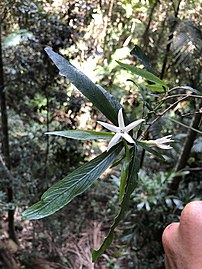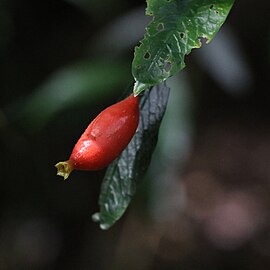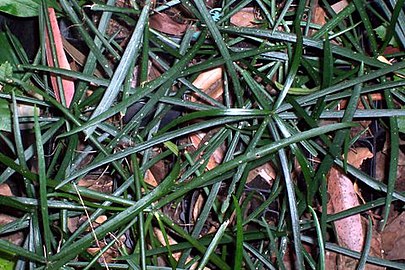Atractocarpus chartaceus
| Narrow-leaved gardenia | |
|---|---|

| |
| Scientific classification | |
| Kingdom: | Plantae |
| Clade: | Tracheophytes |
| Clade: | Angiosperms |
| Clade: | Eudicots |
| Clade: | Asterids |
| Order: | Gentianales |
| Family: | Rubiaceae |
| Genus: | Atractocarpus |
| Species: | A. chartaceus
|
| Binomial name | |
| Atractocarpus chartaceus (
Puttock[3] | |

| |
| Synonyms[3] | |
| |
Atractocarpus chartaceus, commonly known as the narrow-leaved gardenia, is a species of evergreen flowering plant in the coffee family Rubiaceae. It is found in subtropical rainforest of eastern Queensland, Australia, and it is cultivated for its fragrant flowers and colourful fruit.
Description
Atractocarpus chartaceus is an understory shrub or small tree growing up to 6 m (20 ft) in height under ideal conditions, with a stem diameter up to 7.5 cm (3.0 in).[4][5] The trunk is crooked and asymmetrical at the base. The bark is brownish grey, and relatively smooth with some wrinkles or horizontal cracks. The tips of the branchlets have fawn hairs.
The leaves are dark green and
This species is
The fruits are a berry in botanical terms, measuring 15 to 30 mm (0.6 to 1 in) long and 7 to 18 mm (0.3 to 0.7 in) in diameter.[5][6][7] They are orange or red, finely hairy and the remains of the calyx tube is attached at the distal end.[4][5][6] Fruits contain a sweet edible pulp with several 4 to 5 mm (0.16 to 0.20 in) seeds embedded in it.[5][8] They ripen from April to August.[8][9][10]
Taxonomy
The German naturalist and
Etymology
The genus name Atractocarpus is created from the Ancient Greek atractos (spindle) and karpos (fruit). It refers to the shape of the fruit of the type species, Atractocarpus bracteatus. The species epithet chartaceus is derived from the Latin word charta (paper), which is a reference to the thin papery leaves.[9][14]
Distribution and habitat
The natural range of the narrow-leaved gardenia is coastal subtropical forests of eastern Australia, from the
It is usually found on basaltic and alluvial soils where the annual rainfall is between 1,300 and 1,600 mm (51 and 63 in).[4]
Ecology
Atractocarpus chartaceus has been identified as a host plant for the leaf mining larvae of the genus Gracillariidae.[15]
Conservation
This species is listed by both the
Cultivation
Atractocarpus chartaceus has been in cultivation in Australia for some years.[9] It is an attractive garden ornamental with its glossy foliage, scented flowers and colourful fruit, and the flowers attract numerous birds and insects to the garden.[7][8] It prefers a shady position and good drainage.[7][8][9]. It can be propagated from fresh seed, which may take a few months but is usually successful, or from cuttings of the current season's growth.[7][9]
Gallery
-
Growing inWollongong Botanic Gardens
-
Flowers and leaves, northern NSW
-
Fruit at Natural Bridge, Queensland
-
Developing fruit, Australian National Botanic Gardens, Canberra
-
Leaf-miner damage
-
Underside of leaf
-
Juvenile foliage
References
- ^ . Retrieved 27 August 2022.
- ^ a b "Species profile—Atractocarpus chartaceus". Queensland Department of Environment and Science. Queensland Government. 2022. Retrieved 27 August 2022.
- ^ a b "Atractocarpus chartaceus". Plants of the World Online. Royal Botanic Gardens, Kew. Retrieved 27 August 2022.
- ^ doi:10.1071/SB97030. Retrieved 29 August 2022.
- ^ a b c d e f g h i j k l m Harden, G.J.; Nicholson, H.R.W.; McDonald, W.J.F.; Nicholson, N.J.; Tame, T. (2014). Rainforest Plants of Australia - Rockhampton to Victoria. Terania Rainforest Publishing. Retrieved 29 August 2022.
- ^ a b c d e f "PlantNET - FloraOnline". PlantNET (The NSW Plant Information Network System). Royal Botanic Gardens and Domain Trust, Sydney. Retrieved 29 August 2022.
- ^ a b c d e f "Atractocarpus chartaceus (RUBIACEAE); Narrow-leaved gardenia". Brisbane Rainforest Action and Information Network (BRAIN). Retrieved 27 August 2022.
- ^ a b c d e "Atractocarpus chartaceus (Narrow-leaved Gardenia)" (PDF). Gympie & District Landcare. Retrieved 30 August 2022.
- ^ a b c d e f "Atractocarpus chartaceus". Australian Native Plants Society (Australia). Retrieved 27 August 2022.
- ^ a b "Atractocarpus chartaceus (Narrow-leaved Gardenia)". iNaturalist. Retrieved 30 August 2022.
- ^ Essay on the plants collected by Mr Eugene Fitzalan during Lieut. Smith's Expedition to the Estuary of the Burdekin. 1860. Retrieved 27 August 2022 – via Biodiversity Heritage Library.
- ^ Fragmenta Phytographiae Australiae. Vol. 9. 1875. Retrieved 27 August 2022 – via Biodiversity Heritage Library.
- doi:10.1071/SB98001.
- ISBN 9780958174213.
- S2CID 89550732. Retrieved 28 August 2022.
External links
- View a map of recorded sightings of Atractocarpus chartaceus at the Australasian Virtual Herbarium
- See images of Atractocarpus chartaceus on Flickriver








